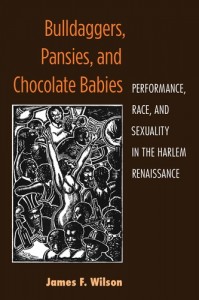 In his introduction, James Wilson writes that “[s]et within the social and artistic context of the so-called Harlem Renaissance, Bulldaggers, Pansies, and Chocolate Babies focuses on the ways in which depictions of blackness and whiteness, male and female, homosexual and heterosexual, highbrow and lowbrow merged and coalesced in the theater and performances of the 1920s and 1930s.†Throughout, Wilson keeps the spotlight firmly on the popular entertainment and celebrated figures of the “low†and “queer†renaissances.
In his introduction, James Wilson writes that “[s]et within the social and artistic context of the so-called Harlem Renaissance, Bulldaggers, Pansies, and Chocolate Babies focuses on the ways in which depictions of blackness and whiteness, male and female, homosexual and heterosexual, highbrow and lowbrow merged and coalesced in the theater and performances of the 1920s and 1930s.†Throughout, Wilson keeps the spotlight firmly on the popular entertainment and celebrated figures of the “low†and “queer†renaissances.
The rowdy and sometimes violent rent party was working class in origin, but attracted a diverse crowd, including slumming tourists from downtown. As a relatively protected outlet for social, sexual, and cultural expression, the rent party was the birthplace of enduring comedy acts, dance fads such as the Charleston and the Lindy Hop, and much music that later entered the mainstream.
Originally promoted as masquerades, drag balls were another Harlem institution. By 1933, the largest of these ticketed events attracted nearly 6,000 spectators of different races, classes, and sexual orientations. Drag shows were popular nightclub fare, and audiences flocked to see the appealingly scandalous Sepia Mae West and Sepia Gloria Swanson.
The Broadway sensation Lulu Belle, a collaboration between white playwrights Charles MacArthur and Edward Sheldon, featured a large integrated cast, although white actors in blackface took the main roles. Critics alternately denounced the play as morally depraved and praised it as morally instructive, but gay men embraced the doomed but ever-glamorous title character and named a club for her in Harlem.
While elected officials enforced a more or less strict code of censorship on Broadway, Harlem was, Wilson writes, generally permitted to “live up to its image as a place of racial and sexual exotica,†since “one of the functions of the ghetto is to provide a controlled site for a certain amount of lawlessness.†Harlem churches, however, crusaded against homosexuality, which they regarded as threatening to the family, and conservative black writers railed against the public’s boundless appetite for sexually charged entertainment.
Wilson devotes his final chapter to Gladys Bentley, a black singer and pianist who began her career as a blueswoman whose bleak laments were securely in the woman-wronged-by-a-man heterosexual tradition. Soon, however, she became known for the unparalleled ribaldry of her popular song parodies, her trademark white tuxedo, and outsized and outspoken personality. She married a white woman in a civil ceremony in New Jersey, and packed the Ubangi Club night after night with admirers who couldn’t seem to get enough. In the 1950s, long after the Great Depression had rendered such carefree fun irrelevant, and an anxious society demanded a strict separation of gender roles, Bentley rejected her former life. In an essay for Ebony magazine titled “I Am a Woman Again,†she declared it had all been a “living hell.†Her only video appearance is from 1958, where she performed as a contestant on You Bet Your Life with Groucho Marx.
Includes 12 black and white photographs, 34 pages of notes, an index, and a bibliography.
Thoroughly researched and thoroughly accessible, Bulldaggers, Pansies, and Chocolate Babies has a broader focus than its title suggests and is recommended for libraries with an interest in GLBT history, U.S. theater history, and African American history.
Reviewed by, Joyce Meggett
Division Chief for Humanities
Chicago Public Library
